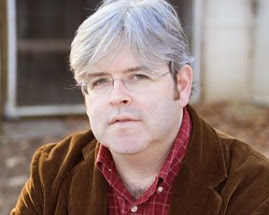 Weinberl: What is it after all that distinguishes man from beast?
Weinberl: What is it after all that distinguishes man from beast?Christopher: Not a lot, Mr. Weinberl.
Weinberl: Trade.
Christopher: I was thinking that.
Weinberl: What would we be without trade?
Christopher: Closed, Mr. Weinberl.
Weinberl: That's it. The shutters would go up on civilization as we know it.
(Tom Stoppard, On the Razzle)
This month, Washington DC's Constellation Theatre Company is tackling On The Razzle -- a play that bears Tom Stoppard's name. But the play is actually the Czech/English playwright's adaptation of a work by another comic genius: the 19th Century Viennese actor/playwright Johann Nepomuk Eduard Ambrosius Nestroy (1801-1862).
Nestroy is an immensely influential figure in German-speaking theatre (and especially in Austria), but his work has never been widely translated into English. Indeed, the only major American volume of Nestroy's work is a long out-of-print translation of three plays -- Johann Nestroy: Three Comedies -- published by Frederick Ungar Publishing in 1967.
That volume had an introduction by American dramatist and novelist Thornton Wilder. And, indeed, almost any knowledge that Americans possess about Nestroy comes from Wilder's two wildly popular adaptations of the same Nestroy play -- Einen Jux will er sich machen (He'll Go on a Spree)-- as The Merchant of Yonkers (1938) and a later revision, The Matchmaker (1955). (The latter play was reworked into Jerry Herman's 1964 musical, Hello Dolly.)
Stoppard's On the Razzle also takes Einen Jux will er sich machen as its foundation, and hews a bit closer to the original play than Wilder's versions. But though Wilder and Stoppard both delight in Nestroy's wildly farcical mistaken identities and sharp satire of sex and commerce, both English-language playwrights share a sense of sheer impossibility of actually reproducing Nestroy's language.
Max Knight and Joseph Fabry, the translators of the 1967 collection, make the best case they can for their efforts, while acknowledging the hurdles: "Nestroy has been imprisoned in his language, the Viennese dialect."
In his foreword, Wilder observes:
Nestroy avails himself of the German language's tendency to compound nouns, forcing adjectival forms from polysyllabic (and polyglot) substantives, wrenching startling associations of ideas from puns, and illuminating philosophical concepts by the use of droll mixed metaphors. Most jokes lose their savor in translation and perish in dissection.
Stoppard is even more blunt in his introduction to On the Razzle:
The text is not, and could not be labelled, "a translation." All the main characters and most of the plot come from Nestroy, but almost none of the dialogue attenpts to offer a translation of what Nestroy wrote.
So who was Nestroy? Why did two great playwrights find something in his "untranslatable" work?
Nestroy was born in Vienna and studied to be a lawyer before being lured into the theatre. He kicked around smaller metropolises in the Austro-Hungarian Empire (Brno, Bratislava, Graz and Lviv among them), working as an actor and a singer before returning to Vienna. He began writing in the political ferment of the decade before the tumultuous revolutionary year of 1848 -- and evaded the theatrical censorship of the era with a mix of subtle wit and improvisation. Much of his efforts were in writing a series of bravura parts for himself, drawing on his own comic timing and skill with language.
The genius of Nestroy was balance his trenchant critique of Viennese society's hypocrisy -- the burgeoning capitalism and sexual license bubbling under a public facade of morality and order -- with a broad and humane delight in the comic fallibility and folly of human beings. He did so in a German that ranged from high to low, painting on the broadest possible canvas of Vienna.
Stoppard catches this aspect of Nestroy wonderfully in another exchange in Act One:
Christopher: Will there be women, Mr. Weinberl?
Weinberl: Beautiful women, Christopher.
Christopher: How old are the women in Vienna, Mr. Weinberl?
Weinberl: Twenty-two, Christopher.
Christopher: How does one meet them, Mr. Weinberl?
Weinberl: They promenade in packs, with parasols, and gloves up to here. They consort with cosmopolitan men-of-the-world in fashionable cafes.
Christopher: I have read that they are often kept, Mr. Weinberl.
Weinberl: Kept for what, Christopher?
Christopher: That's what always puzzled me.
It's no surprise that Constellation's artistic director Allison Arkell Stockman was drawn to Nestroy's mix of farce and ferment -- especially as interpreted by Stoppard. (In the past, Constellation has performed Beaumarchais' The Marriage of Figaro and Vaclav Havel's humane and political Faustian farce Temptation.) It will be interesting to see how director Nick Olcott and the cast and creative team balance the sharpness of the satire and the humanity of the comedy in Stoppard's version -- which are rooted firmly in Nestroy's vision.
(Constellation Theatre Company's production of On the Razzle runs from February 3 through March 6 at Source Theatre -- 1835 14th Street NW. Tickets and more info here.)
(A drawing of Nestroy in the character of the student, Willibald, from his 1847 comedy, The Bad Boys in School, from Wikipedia Commons.)
